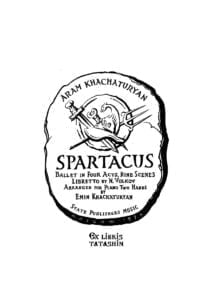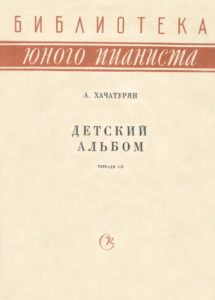Table of Contents
Come join us now, and enjoy playing your beloved music and browse through great scores of every level and styles!
Can’t find the songbook you’re looking for? Please, email us at: sheetmusiclibrarypdf@gmail.com We’d like to help you!
Khachaturian Cziffra – Sabre Dance (piano Solo) sheet music, Noten, partitura, spartiti, 楽譜 , 乐谱
Laden Sie die besten Noten aus unserer Bibliothek herunter.

Best Sheet Music download from our Library.

Please, subscribe to our Library.
If you are already a subscriber, please, check our NEW SCORES’ page every month for new sheet music. THANK YOU!
Aram Khachaturian: The Rhythmic Vitality of Armenian Soul in 20th-Century Music
Aram Ilyich Khachaturian (1903-1978) stands as a colossal figure in 20th-century music, a composer whose vibrant, rhythmically charged, and melodically rich works pulsate with the spirit of his Armenian heritage while achieving universal resonance. More than just the creator of the electrifying “Sabre Dance,” Khachaturian crafted a unique musical language that seamlessly wove Caucasian folk traditions, particularly Armenian, Georgian, and Azeri, into the grand tapestry of Western classical forms and Soviet symphonic tradition. His music is characterized by an infectious energy, lush orchestration, poignant lyricism, and an unmistakable exotic flair that captivated audiences worldwide and secured his place as one of the Soviet Union’s most celebrated and internationally recognized composers.

Browse in the Library:
Or browse in the categories menus & download the Library Catalog PDF:
Roots and Formative Years: Tbilisi to Moscow
- Origins: Born on June 6, 1903, in Tiflis (now Tbilisi, Georgia), Khachaturian grew up immersed in the diverse musical soundscape of the Caucasus. Though Armenian by ethnicity, Tbilisi’s vibrant mix of Armenian, Georgian, Russian, Persian, and Turkish cultures fundamentally shaped his musical sensibilities. The folk songs and dances he heard in the streets and markets became the bedrock of his future style.
- Late Start, Explosive Talent: Remarkably, Khachaturian had no formal musical training until he was 19. Moving to Moscow in 1921 to join his brother, he initially studied biology. However, the pull of music was irresistible. He enrolled at the Gnesin Musical Institute, studying cello and composition under Mikhail Gnesin, who encouraged his exploration of folk idioms.
- Moscow Conservatory: His exceptional talent earned him a place at the prestigious Moscow Conservatory in 1929, studying composition under Nikolai Myaskovsky and orchestration under Sergei Vasilenko. Here, he honed his craft, mastering classical forms while deepening his commitment to expressing his national identity through music. His graduation works, the First Symphony (1934) and the Piano Concerto (1936), immediately announced a major new voice.

The Breakthrough: Concertos and Defining Style
The late 1930s and early 1940s witnessed Khachaturian’s explosive arrival on the international scene:
- Piano Concerto (1936): Dedicated to Lev Oborin (its premiere pianist), this work is a tour-de-force of rhythmic drive, dazzling virtuosity, and folk-inspired melodies. Its infectious energy, particularly in the finale, and its brilliant orchestration made it an instant success, establishing Khachaturian’s signature sound: percussive rhythms, modal harmonies, lyrical yet ornate melodies, and brilliant, colorful orchestration (featuring prominent use of piano, percussion, brass, and woodwinds in distinctive timbres).
- Violin Concerto (1940): Written for the great David Oistrakh, this concerto is arguably Khachaturian’s masterpiece. It perfectly balances fiery, dance-like passages with moments of profound, soulful lyricism. The opening theme is instantly memorable, the slow movement is achingly beautiful, and the finale is a whirlwind of virtuosity and folk dance rhythms. It remains one of the most popular violin concertos of the 20th century.
- Cello Concerto (1946): While perhaps less instantly famous than its predecessors, this concerto shares their virtues: strong rhythmic profile, folk-like melodies (often with a more introspective or melancholic cast), and brilliant interplay between soloist and orchestra. It demands both technical prowess and deep expressiveness from the cellist.

Ballets: “Gayane” and the Birth of “Sabre Dance”
Khachaturian found an ideal canvas for his rhythmic and colorful style in ballet:
- “Happiness” (1939): His first ballet, later reworked into…
- “Gayane” (1942): Composed during the difficult wartime evacuation, “Gayane” is set on an Armenian collective farm. While the plot reflects Soviet ideals, the music transcends ideology. It’s a treasure trove of vivid orchestral depictions, folk dances, and atmospheric scenes. Its enduring legacy comes from the “Sabre Dance” – extracted from Act IV, this frenetic, percussive depiction of warriors displaying their skill became a global phenomenon, a symbol of thrilling orchestral excitement used in countless films, shows, and commercials. Other famous excerpts include the lyrical “Adagio of Gayane and Giko,” the delicate “Dance of the Young Kurds,” and the rousing “Lezginka.”
- “Spartacus” (1954/1968): Khachaturian’s second major ballet is an epic retelling of the gladiator slave rebellion against Rome. It features some of his most grandiose and dramatically powerful music. The “Adagio of Spartacus and Phrygia” is one of the most sublime and widely recognized love themes in all of ballet, radiating warmth and tenderness. The ballet is packed with thrilling battle scenes, noble themes for Spartacus, menacing music for Crassus, and evocative Roman and Greek dances. Like “Gayane,” its suites are concert hall staples.

Orchestral Works and Chamber Music
Beyond concertos and ballets, Khachaturian enriched the orchestral repertoire:
- Symphonies: He wrote three symphonies. The Symphony No. 2 “The Bell” (1943) is a powerful, dramatic wartime work, featuring an actual bell. The Symphony No. 3 “Symphony-Poem” (1947) is grandiose, written for a massive orchestra including organ and 15 trumpets, intended as a celebratory fanfare.
- Suites & Incidental Music: He composed numerous suites drawn from his ballets, film scores (like “Masquerade” – featuring the famous Waltz), and theatre music, ensuring the widest possible audience for his most vivid orchestral writing.
- Chamber Music: Though less central, works like the vibrant Trio for Clarinet, Violin and Piano (1932) and the Sonata for Solo Cello (1974) showcase his melodic gift and rhythmic vitality in a more intimate setting.
The Soviet Context: Recognition and Repression
Khachaturian’s career unfolded entirely within the Soviet system:
- Official Acclaim: He received numerous state honors, including three Stalin Prizes (for the Violin Concerto, “Gayane,” and the Symphony No. 2) and later, the Order of Lenin. He held significant positions within the Composers’ Union.
- The Zhdanov Purge (1948): Like his contemporaries Prokofiev and Shostakovich, Khachaturian fell victim to the infamous decree condemning “formalism” in music. His works (alongside Prokofiev, Shostakovich, Myaskovsky, and others) were denounced as “anti-people,” “modernist,” and “cacophonous.” Performances were banned. This was a deeply traumatic period, forcing public self-criticism and a temporary stylistic shift towards greater simplicity in works like the “Ode in Memory of Lenin” (1948).
- Rehabilitation: Following Stalin’s death in 1953, the restrictions eased. Khachaturian resumed composing in his characteristic style and regained his prominent status, becoming a respected elder statesman of Soviet music. He also became an influential teacher and conductor, promoting music throughout the USSR and internationally.

Legacy: The Enduring Power of Rhythmic Soul
Khachaturian’s legacy is multifaceted and enduring:
- National Voice, Global Appeal: He achieved the remarkable feat of creating a distinctly Armenian voice within classical music that resonated powerfully worldwide. He proved that deep roots in specific folk traditions could produce music of universal excitement and emotion.
- Master of Rhythm and Color: His unparalleled sense of rhythm – driving, complex, often dance-derived – and his brilliant, sensuous orchestration are his most instantly recognizable trademarks. He painted with the orchestra in bold, vivid colors.
- Melodic Gift: Beyond the rhythmic fireworks, Khachaturian possessed a profound gift for long-breathed, expressive, and often ornamented melody, frequently imbued with a soulful, melancholic, or tender quality.
- Bridging East and West: He successfully synthesized the modal scales, melodic contours, and rhythmic patterns of Caucasian folk music with the structures and forces of the Western Romantic and post-Romantic symphony and concerto.
- Cultural Icon: In Armenia and throughout the former Soviet republics, he remains a towering national hero, a symbol of cultural pride and achievement. His music is instantly recognizable and deeply loved.
- Popular Resonance: Pieces like the “Sabre Dance,” the “Adagio from Spartacus,” the “Waltz from Masquerade,” and the Violin Concerto transcend the classical concert hall, permeating popular culture and remaining beloved by audiences of all backgrounds.
Khachaturian: The Fire of the Caucasus
Aram Khachaturian’s music is an irresistible force. It grabs the listener with its primal rhythmic energy, seduces with its lush melodies and exotic colors, and moves with its deep well of lyricism. While firmly grounded in the folk traditions of his Armenian heritage and the realities of Soviet life, his best works possess a vitality and communicative power that transcends time and place. From the visceral thrill of the “Sabre Dance” to the profound tenderness of the “Spartacus Adagio,” from the virtuosic fire of his concertos to the epic sweep of his ballets, Khachaturian’s music remains a vibrant, essential testament to the power of national identity expressed through a universal musical language. He was, above all, a composer who made people feel – with their feet tapping, their hearts swelling, and their spirits lifted by the unmistakable, fiery soul of the Caucasus.
